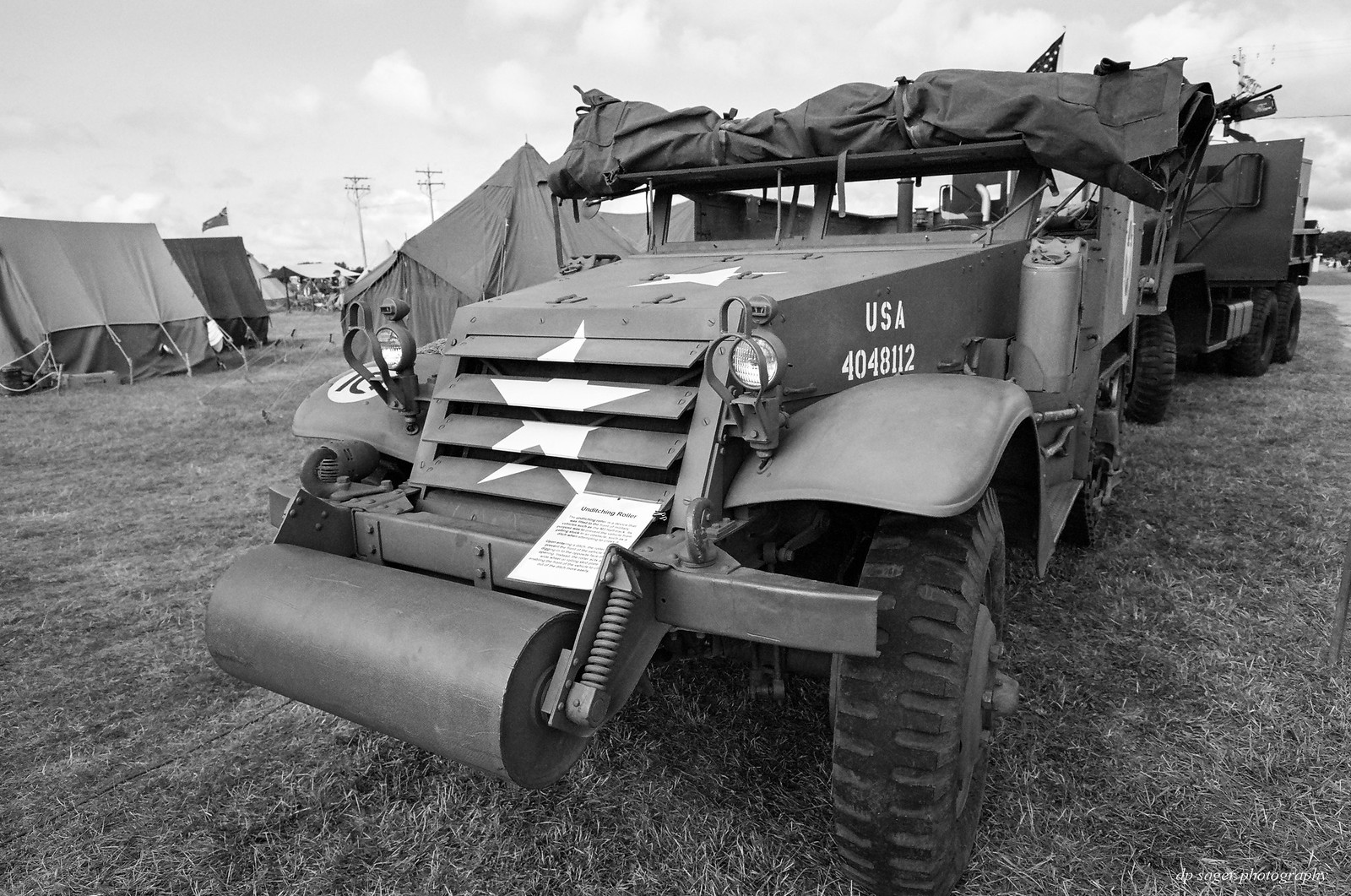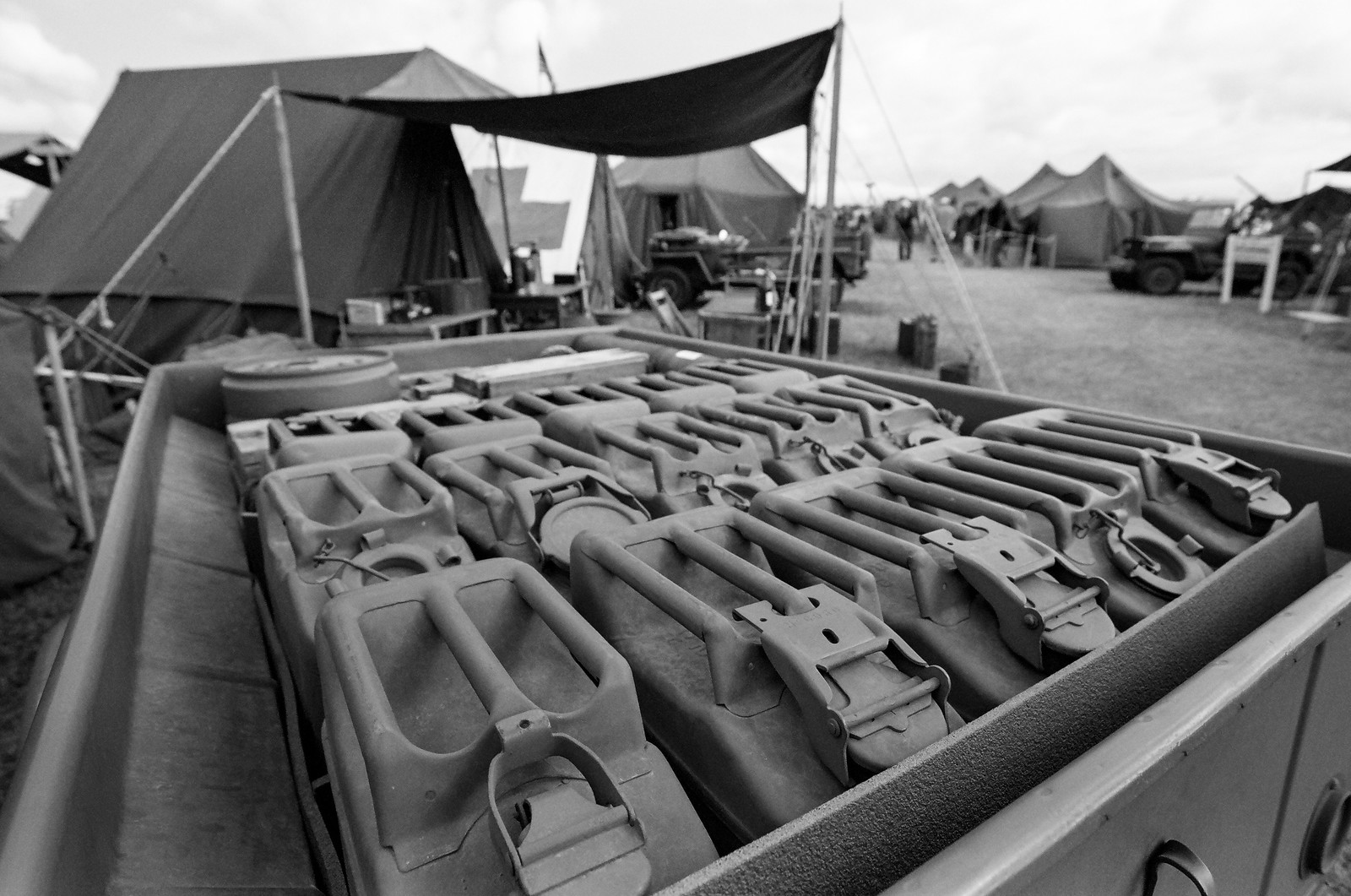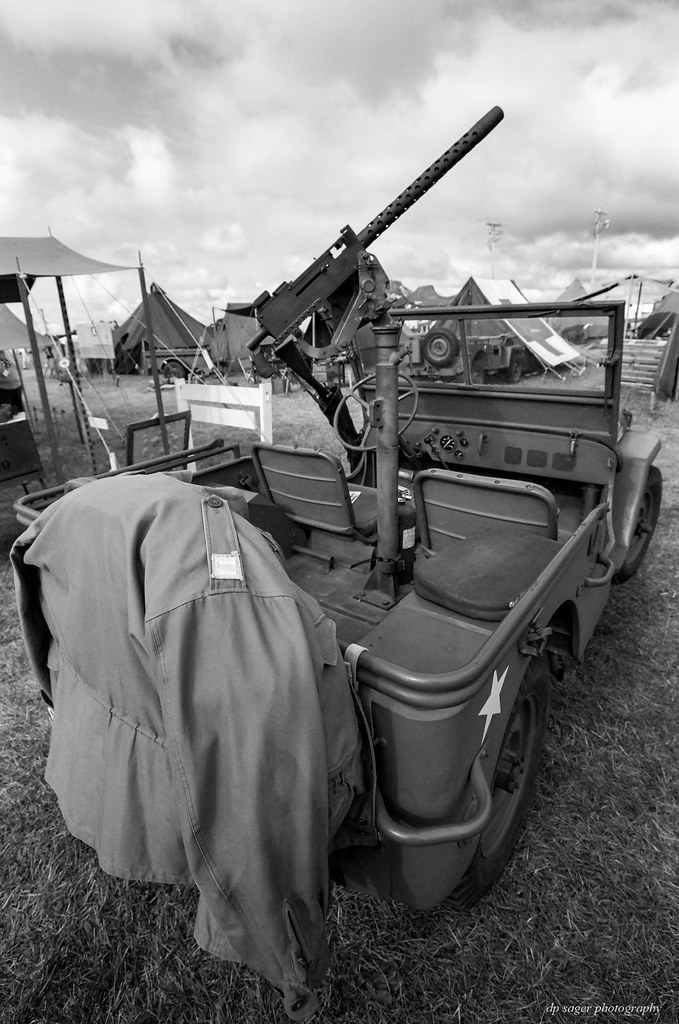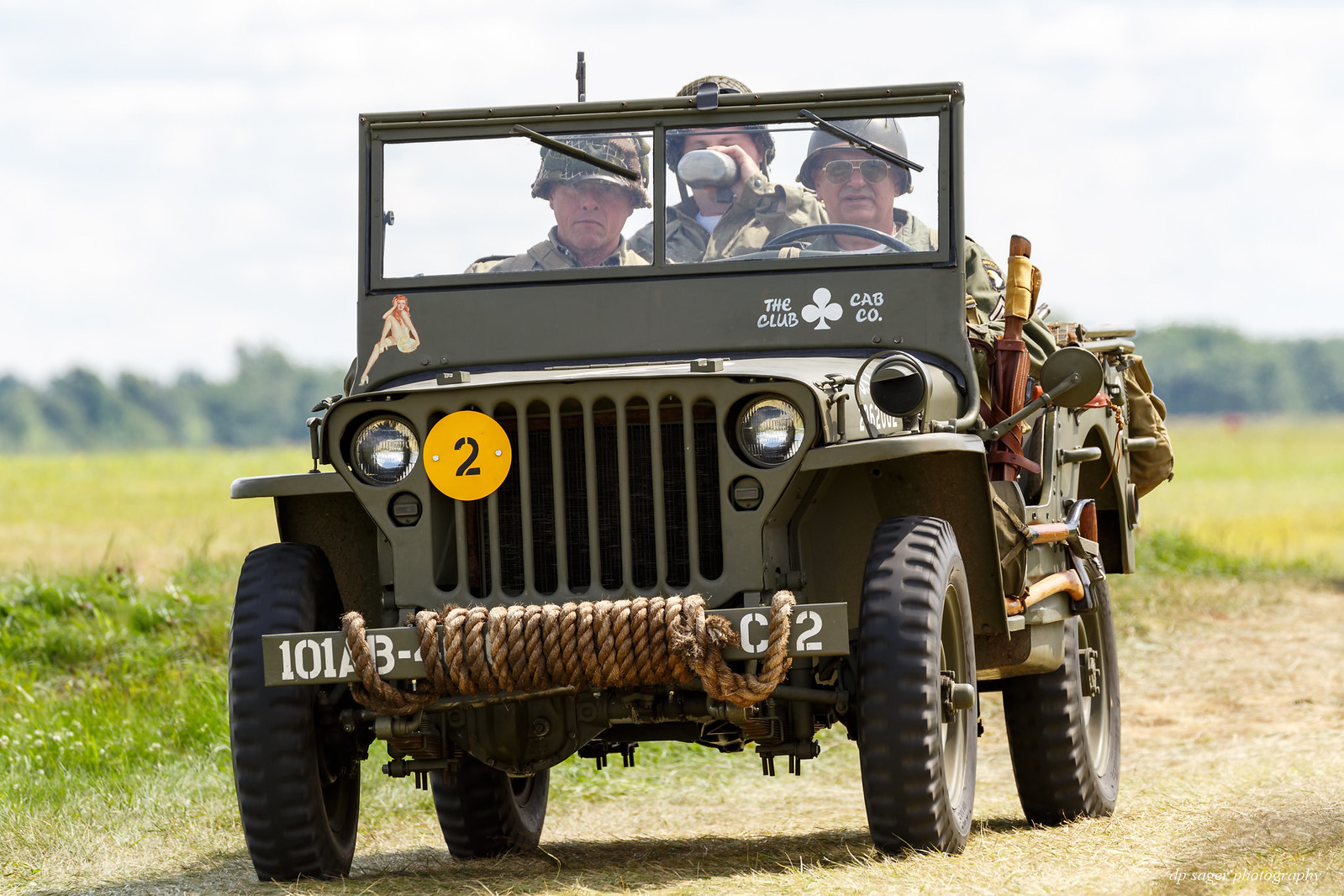Back in the Day at Oshkosh
Aug 21, 2018 08:30:21 #
The M3 Half-track was an American armored personnel carrier widely used by the Allies during World War II. Although at first unpopular due to its lack of significant armor and a roof to protect from shrapnel, the M3 was used by most of the Allies at some point in the war. Total production of the M3 and its variants ran to nearly 65,000 vehicles. To supply the Allied nations, International Harvester produced several thousand of a very similar vehicle, the M5 Half-track for Lend-Lease. The front "Unditching Roller" was an innovation to prevent the front nose of the vehicle from jamming into the far wall when crossing ditches in France and across Northern Europe.
M3 Half-track by Paul Sager, on Flickr

The jerrycan is a liquid container made from pressed steel. The container was designed in Germany in the 1930s for military use to hold 20 litres of fuel (5.3 US gallons). The German design was reverse engineered and subsequently copied by the Allies during the Second World War. The name 'jerrycan' refers to its German origins, Jerry being wartime slang for Germans. Uses for the cans have expanded beyond carrying fuel. Today, a can's use is denoted by its coloring. This prevents contamination of the can's contents by mixing different fuels or mixing fuel with water.
Petrol on film

The jeep became the primary light wheeled transport vehicle of the United States Military and its Allies in World War II, as well as the postwar period. The Jeep was the workhorse of the American military, as it literally replaced the use of horses and other draft animals (still abundant in World War I) in every role, from cavalry units to supply trains. Willys-Overland filed to trademark the "Jeep" name in 1943, and from 1945 onwards, Willys marketed its four-wheel drive vehicle to the public with its CJ (Civilian Jeep) versions, making these the world's first mass-produced 4WD civilian cars.
Willys MB

Historians don't know how exactly the U.S. Army's 1/4-ton reconnaissance car became generally known as the "Jeep". One frequent explanation is the designation GP (either from the initial Ford GP, or from the military G.P. for General Purpose car) was slurred into the word Jeep in the same way that the contemporary HMMWV (for High-Mobility Multi-purpose Wheeled Vehicle) has become known as the Humvee.
Willys MB Jeep

On June 6, 1944, That’s All Brother was one of the over 800 C-47s that dropped 13,000 paratroopers into France behind German lines during the Normandy Invasion. The 75th anniversary is next summer in June 2019.
C-47 Skytrain That's All Brother

The B&W images were captured using expired Kodak Portra 400BW and an orange filter. Processing and scanning was performed by North Coast Photography Services and the high res JPEGs were processed further in Lightroom. The color image is from a Canon EOS 5DIII.
The images are sized to fill your wide-screen display. Try using <F11> to maximize your browser window for the full effect. If the images overshoot your display, such as a laptop, just click on the image or the URL link and they'll resize to your screen from the host Flickr site. You can click a bit further into the image details on the Flickr page, if desired. EXIF data is available from the host Flickr pages as well. On the Flickr site, use your <L>key for Large and the <F11> for the full-screen.
M3 Half-track by Paul Sager, on Flickr

The jerrycan is a liquid container made from pressed steel. The container was designed in Germany in the 1930s for military use to hold 20 litres of fuel (5.3 US gallons). The German design was reverse engineered and subsequently copied by the Allies during the Second World War. The name 'jerrycan' refers to its German origins, Jerry being wartime slang for Germans. Uses for the cans have expanded beyond carrying fuel. Today, a can's use is denoted by its coloring. This prevents contamination of the can's contents by mixing different fuels or mixing fuel with water.
Petrol on film

The jeep became the primary light wheeled transport vehicle of the United States Military and its Allies in World War II, as well as the postwar period. The Jeep was the workhorse of the American military, as it literally replaced the use of horses and other draft animals (still abundant in World War I) in every role, from cavalry units to supply trains. Willys-Overland filed to trademark the "Jeep" name in 1943, and from 1945 onwards, Willys marketed its four-wheel drive vehicle to the public with its CJ (Civilian Jeep) versions, making these the world's first mass-produced 4WD civilian cars.
Willys MB

Historians don't know how exactly the U.S. Army's 1/4-ton reconnaissance car became generally known as the "Jeep". One frequent explanation is the designation GP (either from the initial Ford GP, or from the military G.P. for General Purpose car) was slurred into the word Jeep in the same way that the contemporary HMMWV (for High-Mobility Multi-purpose Wheeled Vehicle) has become known as the Humvee.
Willys MB Jeep

On June 6, 1944, That’s All Brother was one of the over 800 C-47s that dropped 13,000 paratroopers into France behind German lines during the Normandy Invasion. The 75th anniversary is next summer in June 2019.
C-47 Skytrain That's All Brother

The B&W images were captured using expired Kodak Portra 400BW and an orange filter. Processing and scanning was performed by North Coast Photography Services and the high res JPEGs were processed further in Lightroom. The color image is from a Canon EOS 5DIII.
The images are sized to fill your wide-screen display. Try using <F11> to maximize your browser window for the full effect. If the images overshoot your display, such as a laptop, just click on the image or the URL link and they'll resize to your screen from the host Flickr site. You can click a bit further into the image details on the Flickr page, if desired. EXIF data is available from the host Flickr pages as well. On the Flickr site, use your <L>key for Large and the <F11> for the full-screen.
Aug 21, 2018 08:42:53 #
Interesting, i handleded many a Jerry Can but never knew where the name came from. Also very familiar with the Jeep and it’s lack of a heater and propensity to turn over. Pictures are great bringing back memories. Our did not have the 50 cal gun.
Aug 21, 2018 08:58:44 #
Aug 21, 2018 09:27:34 #
Aug 21, 2018 09:32:04 #
Aug 21, 2018 11:27:03 #
Enjoyed them all, along with the history lesson. It is nice to finally know where the term “CJ” came from.
Aug 21, 2018 15:03:24 #
al13 wrote:
Interesting, i handleded many a Jerry Can but never knew where the name came from. Also very familiar with the Jeep and it’s lack of a heater and propensity to turn over. Pictures are great bringing back memories. Our did not have the 50 cal gun.
The "new" quarter tons that came into use in 1970 were with individually suspension wheels. They were "guaranteed" to lay down on their sides in curves taken at 35 MPH. And they did. Someone I know (me) almost got killed in one. That one had a sticker professing "Break-in miles 5000". It was broken in at 3700.

Appreciate the sharing of the shots.


Aug 21, 2018 16:18:59 #
Stephan G wrote:
The "new" quarter tons that came into us... (show quote)
Glad you enjoyed the pictures and memories, Stephan! I didn't expect the "camp" at the airshow with several soldiers in period uniforms.
Aug 21, 2018 16:22:59 #
NMGal wrote:
Enjoyed them all, along with the history lesson. It is nice to finally know where the term “CJ” came from.
Thank you NMGal! I'd forgotten that jeep wasn't always American Motors (now Fiat). From the Jeep wiki page, it seems a few companies have been fighting over the trademark since the 40s.
Aug 21, 2018 16:23:31 #
danniepolley wrote:
Excellent photo set and interesting story
Thank you danniepolley, glad you enjoyed!
Aug 21, 2018 16:23:57 #
Photog8 wrote: Good shots and information. Thanks.
Good shots and information. Thanks.
 Good shots and information. Thanks.
Good shots and information. Thanks.Thank you Photog8, glad you enjoyed!
Aug 21, 2018 16:24:41 #
loosecanon wrote:
A really fascinating story with excellent photos. Thanks for sharing.
Thank you loosecanon! It was fun to search out some details, glad you enjoyed.
Aug 21, 2018 16:25:34 #
al13 wrote:
Interesting, i handleded many a Jerry Can but never knew where the name came from. Also very familiar with the Jeep and it’s lack of a heater and propensity to turn over. Pictures are great bringing back memories. Our did not have the 50 cal gun.
Thank you al13! Glad you enjoyed the images and memories.
Aug 21, 2018 16:52:29 #
CHG_CANON wrote:
Thank you NMGal! I'd forgotten that jeep wasn't always American Motors (now Fiat). From the Jeep wiki page, it seems a few companies have been fighting over the trademark since the 40s.
The rights to the design was taken away from Willys and given to Ford, Chevy and other big name car makers with the excuse that Willys could not provide the quantity needed. As it was, they had to bring Willys in to fix the glitches created by the "Big 3" to the winning design. As often through the years, the US Government played fast and loose with the national defense card.
Aug 22, 2018 06:37:43 #
CHG_CANON wrote:
The M3 Half-track was an American armored personne... (show quote)
A fantastic set of images!!!
My father was stationed at Ft.Sill Ok. from 1928 to 1937 while it was Field Artillery base they did field test on the first Half-Tracks, it was not a pretty sight, due to a poor design, if a track broke at high speed it would fly forward and hit the driver, the flaw being the drive sprockets were at the front of the track, a change was made putting the sprockets at the rear seemed to make it safer.
If you want to reply, then register here. Registration is free and your account is created instantly, so you can post right away.





